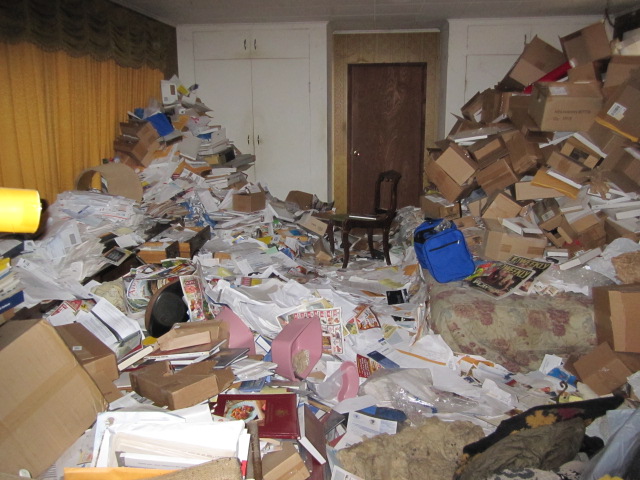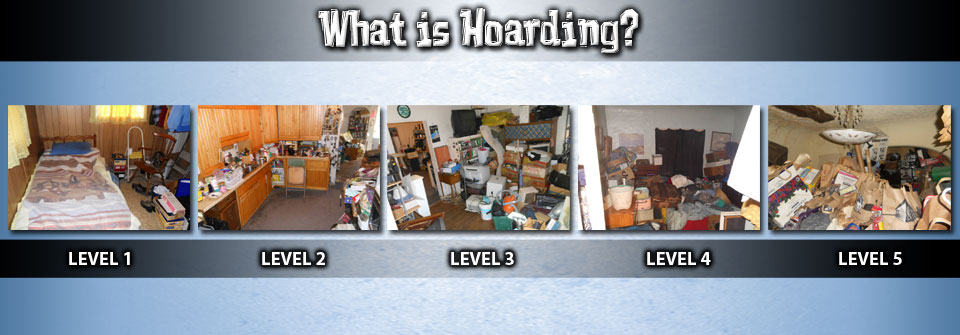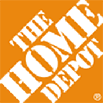What is Hoarding
The easiest definition of hoarding is when the amount of acquired clutter prohibits functionality in the home. This means that functional areas such as kitchens, bathrooms, bedrooms and dining rooms cannot be used for their intended purpose. There are 5 levels of hoarding, 1 being minor clutter and 5 being blocked rooms, pathways, animal/human waste, limited ingress and egress, etc. Remember level 5 hoarding cases do not happen overnight, so a level 2 or 3 can quickly become a level 5 if proper methods are not utilized to prevent it.
The main criteria for hoarding is when the amount of clutter (any types of objects) impedes with the functionality of a home, so rooms cannot be used for their intended purpose. So, if you don’t know if a situation is hoarding or not, just ask yourself if all the spaces are functional. Can you sleep in your bed? Can you take bath or shower? Can you cook in the kitchen, or eat at the dinner table? If you answer no to questions like this, then hoarding is most likely present. The other important part to hoarding is the inability for the person to let go of items, no matter the importance or value of the item.

Levels Of Hoarding:

There are 5 levels to hoarding. You can see the levels and photo examples of each below.
Level 1 Hoard – Very minor clutter that causes no issues with functionality. But the scale needs to start somewhere, right?
Level 2 Hoard – Typically horizontal surfaces are covered, including countertops, tables, desks, etc. but the home is still usable and there is open floor spaces.
Level 3 Hoard – In addition to horizontal surfaces being filled, the perimeters of rooms start filling as well, encroaching on the living spaces.
Level 4 Hoard – No floors are starting to fill up and functionality is almost non existent. There are limited access to many parts of the home.
Level 5 Hoard – The most severe hoards where rooms are not able to be entered; ingress and egress can be completely blocked; the weight of the contents themselves put stress on the structure and become a fire hazard; there are rodent and insect infestations; potential structural hazards and fire dangers present; odors are typically very strong and neighbors may be complaining
Above are some examples of different hoarding levels. (insert images)
Types of hoarding
Hoarding affects all types of people, young and old, male and female. The type of clutter that is found within a household oftentimes reflect the interests, hobbies or career of the individual, although sometimes the type of clutter may seem completely random, also. Either way, the fact of the matter is that the hoarding is affecting the individual’s life, and may be affecting those surrounding them as well. In the end, the hoarder’s lifestyle may be dramatically altered, ranging from a limited social life to being cut off from family and friends as a direct or indirect result of hoarding. This ultimately leads to the hoarder becoming more and more attached to the clutter that surrounds them, relying on their “stuff” for social interaction and comfort. In the case of animal hoarders, this may be truer, with the hoarder finding solace and companionship in their pets.
In our experience, we have found that the most common cases of hoarding exist within certain trends or labels. Listed below are the most common hoarding cases that we have worked with through our 16 years of experience. Some are actual medical terms, while some are simply descriptions of the type of hoarding that is affecting the home.
• ANIMAL HOARDING
A person that acquires more animals than they can properly care for is classified as an animal hoarder. The reality is, animal hoarders typically begin their accumulation with the best intentions-whether saving animals, providing shelter, adoption, or one of the many other reasons for animal hoarding-their pure intentions soon fade into the background as the inability to properly care for the growing number of animals becomes more evident. As the accumulation of animals grows, either through the steady acquisition of more animals or through the animals producing litters of their own, the situation can quickly spiral out of control. The loss of control often results in the animals often becoming sick or worse, dying.
More often than not, we encounter animal hoarder’s homes that are also affected with the general accumulation of clutter. These homes can present extremely dangerous conditions due to the safety issues contributed to the clutter in addition to the animal waste issues that are present within the home. These homes need to be addressed by professionals that specialize in animal hoarding and hoarding scenarios before the home is safe for re-occupancy. Steri-Clean, Inc. offers a cleanup program that is dedicated and specific to your particular needs, while providing the remediation services needed in these scenarios to restore the home to a safe, clean, and functional living environment. Please visit our ANIMAL HOARDING page for more information and pictures.
• BIBLIOMANIA (HOARDING OF BOOKS) / INFORMATION HOARDER
Also referred to as an information hoarder or a knowledge hoarder, this category of hoarding typically involves individuals with an extremely high intelligence. These hoarders may hold careers that require a large amount of research or the obtaining of career related materials (i.e. teachers, engineers, scientists, accountants, lawyers, etc.). The information hoarder justifies the accumulation of clutter through their never-ending quest for knowledge. We have seen information hoarding cases vary in degree and type, from a home that contained tens of thousands of books, to a home where the homeowner, a retired CPA, had rooms overflowing with work files, financial paperwork, and career related materials that dated 40 plus years old. In all of these cases, the collection of information is vital to the day-to-day process of the hoarder, no matter how unlikely the use is for all of this information. It is as if letting go of the books, magazines, and information that has accumulated to overwhelming levels will be like letting go of a part of themselves.
• SYLLOGOMANIA (HOARDING OF TRASH/GARBAGE)
Syllogomania is defined as the hoarding of pure trash. Although pure syllogomania hoarding cases - where there are no items of value, sentiment, or functional use - are rarely seen, they do exist. When we encounter these types of hoarding cases, generally the overall conditions of the home are despondent. Extremes have usually been met, such as utilities being completely shut off, and the home being contaminated with a combination of insects, rodents, and gross filth conditions. These individuals in general tend to have more severe symptoms of mental disorder than the average hoarder. These symptoms require specialized treatment from not only a mental health standpoint, but also in addressing the conditions of the home. Only a company that values the human element like Steri-Clean, Inc. can be trusted to compassionately tend to the remediation needs of these individuals.
• LARDER HOARDING (HOARDING OF FOOD)
Larder hoarding, or more commonly known as food hoarding, is mainly contributed to the fear of losing everything. This fear drives the individual to stockpile items that may assist in a perceived “survival mode,” where they are forced to live off of their stockpile. Although everyone should have some kind of reserve in case of emergency situations, such as a natural disaster or losing a job, these individuals take this ideal to an extreme by turning their home into a storage unit for their excessive stockpile of food and other items. The large majority of the items in these scenarios go remain untouched and unused. Food hoarders are difficult to reason with, taking as example the fact that many of them do not see any validity behind expiration dates for food items.
• RECYCLERS
A recycler is usually a hoarder that has large piles of plastics, glass, and aluminum cans throughout their home that far exceeds the normal amount that an average household may contain. These individuals will retain the intention in their minds that they will recycle all of the contents of their home which will bring them large amounts of cash. However, the piles continue to increase in size and scope to the point where entire rooms are filled with potential cash as the intention of recycling never materializes. Additionally, the amount of recyclables that fill the home becomes so extensive that it would literally take dozens upon dozens of trips to the recycling center to remove all of the items for recycling. Steri-Clean, Inc. has worked with numerous clients that have needed our help in recycling. In these cases, we will transport all recyclables to a local recycling center for the homeowner and provide the cash and receipts as requested. Also, our vehicles are large enough so that we can cut the dozens of trips to the recycling center down to a handful, and ultimately fulfill that original intention of recycling that the homeowner had.
• COLLECTORS
Collectors typically start off collecting a certain category or group of items. In almost all of these cases though, eventually the collection grows to a point that exceeds the control of the individual or the collector sparks a new interest in a new collection of items. The collection ultimately grows to a size where it is considered hoarding due to the fact that the collection is interfering with the daily functioning of the household. Although the collector may not have been considered a hoarder upon starting the collection, a slippery slope evolves from the situation due to items being used for the day-to-day functioning of the home are either lost or inaccessible due to the collection taking over the home. This almost always leads to the accumulation of every day clutter on top of the already large collections within the home.
• SHOPAHOLICS
When we meet with hoarders that appear to be shopaholics, we understand that this is not the case most of the time. Remember that most hoarders over time lose a large part of their social lives and find themselves feeling alone without the joys and happiness their lives were once filled with. The thrill of a bargain creates a high, and a release of endorphins that gives them a quick boost of happiness and joy we call the "high". Unfortunately as they drive the items home, or the items are being shipped to their residence the high is a little less and by the time the items arrive at their homes, the high is completely gone. The items were not truly needed in the first place and with the rush of positive feelings now gone, the items are simply placed in a pile, and rarely will any of them be used.
This replacement of true emotions and positive feelings by shopping can not only quickly fill a residence, but can put the hoarder in a terrible financial state with credit cards racking up large balances. The stress of compiling debt and growing clutter compounds the depression. This is yet another way a hoarders lack of true interactions with people and finding healthy ways to get happiness from life spirals them deeper and deeper into a world of isolation, clutter and financial debt.
We work with many hoarders that suffer from compulsive purchasing. Through our understanding of this disorder and our compassion, patience and desire to help we can help the hoarder de-clutter their homes, return many of the unused and unopened items and show them ways to bring fulfillment and self worth back into their lives. "Stuff" will never replace the people and real things that hoarders are so often missing. Call us today if you or a loved one's suffer from compulsive purchasing and let us help you get back on track







